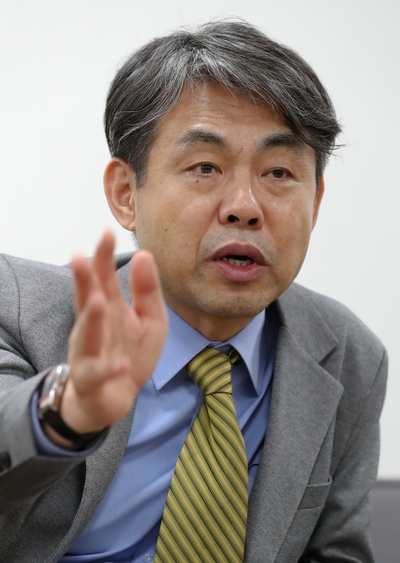Posted on : Dec.21,2018 16:31 KST
Modified on : Dec.21,2018 16:46 KST
 |
|
South Korean Office Secretary General Kim Chang-su of the inter-Korean joint liaison office in Kaesong.
|
285 face-to-face meetings and deliberations at the liaison office thus far
 |
|
South Korean Office Secretary General Kim Chang-su of the inter-Korean joint liaison office in Kaesong.
|
Shortly after the inter-Korean joint liaison office opened in Kaesong on Sept. 14, South Korean Office Secretary General Kim Chang-su was talking to his North Korean counterpart, Deputy Director Hwang Chung-song.
“Essentially, our job is creating standards for inter-Korean relations. We have to approach this as if we’re walking through a snowfield for the first time,” Kim said.
“What you said about the snowfield, that’s a reference to Kim Koo, isn’t it?” Hwang said.
Dec. 23 will be the 100th day of operations at the liaison office, the first organization of its kind in the 70 years of the Korean Peninsula’s division.
“Every day at the liaison office is part of the process of building trust between South and North Korea. The heart of the name ‘inter-Korean joint liaison office’ is the word ‘joint.’ We always emphasize that problems should be solved with the attitude of joint ownership,” Kim said in an interview with the Hankyoreh on Dec. 20 at the central government complex in Seoul.
As of Dec. 19, there have been 285 face-to-face meetings and deliberations at the liaison office. That works out to 2.9 meetings a day, setting a record for the most contact in the shortest amount of time since the peninsula was divided. South Korea’s Hyundai Asan and North Korea’s Asia-Pacific Peace Committee held preliminary deliberations at the liaison office before an event marking the 20th anniversary of the opening of tours to Mt. Kumgang in North Korea.
The liaison office was in charge of streamlining the visa process for inter-Korean forestry cooperation staff when they traveled to Pyongyang via Beijing, and it also handled deliberations for the swift repatriation of a South Korean fishing boat that was apprehended by the North Korean navy in the East Sea in November. The office is on its way to becoming the platform for inter-Korean communication, in both the public and private sectors.
On any given day, an average of 50 South Korean public servants and civilians are based at the joint office.
“We get really important hints not only from official deliberations but also through humdrum routine conversation,” Kim said. For example, there were tangible, if not official, movements by the North Koreans in November in connection with Kim Jong-un’s reciprocal visit to Seoul, but those movements disappeared in December.
Or take Kijong-dong, also known as Peace Village or Propaganda Village, North Korea’s southernmost village that’s famous for a massive North Korean flag flying atop a 160m tower. When Kim asked about the village, North Korean staff let him in on the latest news. “They’ve changed its administrative name to Panmunjom Village. A woman is in charge of the flag, and she raises and lowers the flag with an electric motor. When the motor breaks down, she has to climb up and fix it. She sounds like a pretty impressive person!”
Every day at the liaison office, the workers never stop “walking through the snowfield” to escape from the trap of hostility and misunderstanding,” he added.
By Lee Je-hun, senior staff writer
Please direct comments or questions to [english@hani.co.kr]










